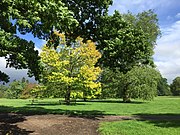Llanover House
The house survived her by some 40 years and was demolished in 1936. The Llanover estate remains in the ownership of her descendants. It is designated at Grade II* on the Cadw/ICOMOS Register of Parks and Gardens of Special Historic Interest in Wales. The gardens and grounds are occasionally open to the public.
History
In 1792, Benjamin Waddington (1749-1828), the third son of the Rev. Joshua Waddington (1711-1780), who was born in Walkeringham, Nottinghamshire bought Tŷ Uchaf, an 'ill-built, incomplete, & inelegant dwelling house' in Monmouthshire, where he laid out an extensive park. His daughter, Augusta was born at the house in March 1802. In 1823, Augusta married Benjamin Hall, a successful engineer and politician, and owner of the adjacent Llanover estate, which was united with Ty Uchaf on Augusta's inheriting following the death of her father. In 1828 the Halls determined to build a new house at the centre of their unified estate. Thomas Hopper was commissioned to design a large, three-storey house, in a Jacobethan style. Building was complete by 1837.
The Halls devoted considerable attention to the development of Llanover as a model estate village, although John Newman, in his Gwent/Monmouthshire volume of the Pevsner Buildings of Wales, notes that much of the current building estate dated from the time of their grandson, Ivor Herbert, 1st Baron Treowen. In addition to the construction of cottages for the estate workers, schools for their children, and chapels for them all to worship in, Lady Llanover established a number of temperance inns, as a firm advocate of abstinence.
Lady Llanover's first passion, however, was the promotion of Welsh culture and language. A Welsh speaker herself, she employed Welsh-speaking servants, had instruction in her estate schools undertaken in Welsh, and required that the services at St Bartholomew's Church were conducted in Welsh. At a national level, Lady Llanover supported the Cymreigyddion Society, funded Daniel Silvan Evans in the production of his Welsh dictionary, purchased the Llanover Manuscripts collection from the son of Iolo Morganwg, supported the Eisteddfod movement, adopting her own bardic name, Gwenynen Gwent (The Bee of Gwent), and encouraged the study and use of the Welsh harp and Welsh costume.
Lord Llanover died in 1867 and was buried at St Bartholomew's. Lady Llanover outlived him by 30 years, although becoming increasingly withdrawn from society. She died in 1898 and was buried in the family tomb, following a service conducted in Welsh.
Llanover House was demolished in 1936. The Llanover Estate remains a privately owned estate in possession of the Hall's descendants. The gardens are occasionally opened to the public.
Architecture and description
LLanover House was built in a Jacobethan style, with three main storeys and grouped sets of chimney stacks. After demolition in 1936, the stables fell into disuse but still stand in a ruinous state, and are listed at Grade II. Ty Uchaf remains and is also a Grade II listed building. The gardens and park surrounding the house are listed Grade II* on the Cadw/ICOMOS Register of Parks and Gardens of Special Historic Interest in Wales.
Gallery
-
Lady Llanover, the "Bee of Gwent"
-
Lord Llanover
-
St Bartholomew's, Llanover, burial place of Lord and Lady Llanover
-
Ty Uchaf, Augusta Hall's ancestral home
-
The Hanover Chapel
-
Llanover Park
Notes
- ^ Hopper was a versatile architect, capable of building in whatever style his patrons desired. Howard Colvin records his Neoclassical style at Kinmel Hall, Romanesque Revival at Penrhyn Castle, Tudor Gothic at Margam Castle, and Jacobethan at Llanover.
- ^ Although the authenticity of some of Lady Llanover's cultural traditions has subsequently been questioned, her efforts in the middle of the 19th century have seen Llanover described as a "Welsh cultural utopia".
References
- ^ Forder, Helen (2012). High Hats and Harps. United Kingdom: TallyBerry. p. 1. ISBN 978-0-9570278-3-1.
- ^ de Bunsen, Baroness (1960). "Reminences". The National Library of Wales Journal. XI (4 (Winter)): 285–329. Retrieved 17 May 2024.
- ^ Newman 2000, pp. 328–333.
- ^ "Cymdeithas Gwenynen Gwent". The Lady Llanover Society. Retrieved 22 February 2023.
- ^ Newman 2000, pp. 330–333.
- ^ Löffler, Marion. "Hall, Augusta, Lady Llanover ('Gwenynen Gwent') (1802-1896), patron of Welsh culture and inventor of the Welsh national costume". Dictionary of Wales Biography. National Library of Wales. Retrieved 22 February 2023.
- ^ "Llanover House (45084)". Coflein. RCAHMW. Retrieved 22 February 2023.
- ^ Curl 2016, p. 369.
- ^ Colvin 1978, pp. 433–434.
- ^ "Augusta Hall, Lady Llanover (1802-1896)". Peoples Collection Wales. Retrieved 22 February 2023.
- ^ "Women's History Month: The Woman who invented Welsh national dress". 12 March 2011.
- ^ Hill, Pete (2 April 2012). "More Welsh than the Welsh?". First Media. Retrieved 22 February 2023.
- ^ Jones, Rhian E. (11 June 2019). "How Welsh culture learned to assert itself". New Humanist. Retrieved 22 February 2023.
- ^ Gurden-Williams 2008, Introduction.
- ^ "Visit Us". Llanover Estate. Retrieved 22 February 2023.
- ^ Cadw. "Old Stable Block (ruin) at Llanover Park (Grade II) (87177)". National Historic Assets of Wales. Retrieved 22 February 2023.
- ^ Cadw. "Ty Uchaf (Grade II) (1929)". National Historic Assets of Wales. Retrieved 22 February 2023.
- ^ Cadw. "Llanover Park (PGW(Gt)41(MON))". National Historic Assets of Wales. Retrieved 6 February 2023.
External links
Sources
- Colvin, Howard (1978). A Biographical Dictionary of British Architects 1600-1840. London, UK: John Murray. ISBN 978-0-719-53328-0.
- Curl, James Stevens (2016). Oxford Dictionary of Architecture. Oxford: Oxford University Press. ISBN 978-0-199-67499-2.
- Gurden-Williams, Celyn (2008). Lady Llanover and the creation of a Welsh cultural utopia. Cardiff: Cardiff University. OCLC 1118129383.
- Newman, John (2000). Gwent/Monmouthshire. The Buildings of Wales. Penguin. ISBN 0-14-071053-1.





